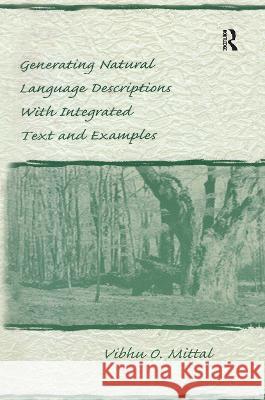Generating Natural Language Descriptions with Integrated Text and Examples » książka
Generating Natural Language Descriptions with Integrated Text and Examples
ISBN-13: 9780805824148 / Angielski / Twarda / 1998 / 264 str.
Generating Natural Language Descriptions with Integrated Text and Examples
ISBN-13: 9780805824148 / Angielski / Twarda / 1998 / 264 str.
(netto: 672,22 VAT: 5%)
Najniższa cena z 30 dni: 654,86 zł
ok. 22 dni roboczych
Bez gwarancji dostawy przed świętami
Darmowa dostawa!
This book discusses issues in generating coherent, effective natural language descriptions with integrated text and examples. This is done in the context of a system for generating documentation dynamically from the underlying software representations.
Good documentation is critical for user acceptance of any complex system. Advances in areas such as knowledge-based systems, natural language, and multimedia generation now make it possible to investigate the automatic generation of documentation from the underlying knowledge bases. This has several important benefits: it is always accessible; it is always current, because the documentation reflects the underlying representation; and, it can take the communication context, such as the user, into account.
The work described in this book compiles results from cognitive psychology and education on effective presentation of examples, as well as work on computational generation of examples from intelligent tutoring systems. It also takes into account computational learning from examples, and a characterization of good examples for just this purpose. Issues arising from these research areas--as well as issues coming from the author's own corpus analysis of instructional and explanatory texts--are discussed in the context of generating natural language descriptions of software constructs.
A text planner is used for a hierarchy of communicative goals. Examples are treated as an integral part of the planning process and their interaction with text is represented at all stages. The strengths and limitations of this approach are also discussed. Although the focus of this book is the generation of natural language descriptions, a similar set of issues need to be addressed in the generation of multimedia descriptions.
This book will be of interest to all researchers working in the areas of natural language interfaces, intelligent tutoring systems, documentation and technical writing, and educational psychology.











